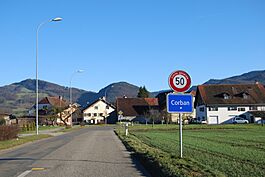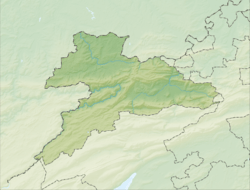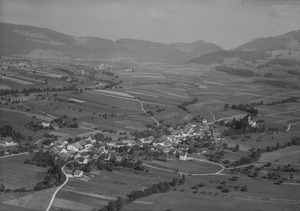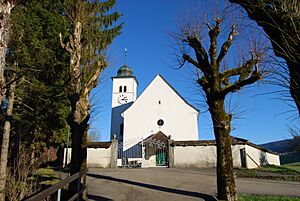Corban, Switzerland facts for kids
Quick facts for kids
Corban
|
||
|---|---|---|

Corban village
|
||
|
||
| Country | Switzerland | |
| Canton | Jura | |
| District | Delémont | |
| Area | ||
| • Total | 7.87 km2 (3.04 sq mi) | |
| Elevation | 525 m (1,722 ft) | |
| Population
(December 2005)
|
||
| • Total | 467 | |
| • Density | 59.34/km2 (153.69/sq mi) | |
| Postal code |
2826
|
|
| Surrounded by | Courchapoix, Vermes, Mervelier, Montsevelier, Bärschwil(SO) | |
Corban is a small village that used to be a separate town (called a municipality) in Switzerland. It is located in the Jura canton, which is like a state or region in Switzerland. Corban is part of the Delémont district.
On January 1, 2018, Corban joined with other nearby villages to form a new, larger municipality called Val Terbi. This means Corban is no longer a separate town on its own.
Contents
A Look Back: Corban's History
Corban has a long history! The village was first mentioned in official records way back in 1184. At that time, it was known by a different name, Bathendorf.
Later, in 1240, it was called Corpaon, which is much closer to its modern name, Corban.
Exploring Corban's Geography
Corban is a beautiful place with lots of open space. About 62.5% of its land is used for farming, which means there are many fields and pastures. Forests cover a big part of the area, about 33.1% of the land.
The village itself, with its buildings and roads, takes up about 4.5% of the land. There are also small rivers and streams flowing through the area.
Corban is located in the eastern part of a valley called Val Terbi. Several nearby towns, including Corban, Courchapoix, Courroux, Mervelier, Montsevelier, Vermes, and Vicques, have decided to join together to form the new municipality of Val Terbi.
Understanding Corban's Coat of Arms
A coat of arms is like a special symbol or emblem for a town or family. Corban's coat of arms is blue with a silver stripe going across it.
In 2004, two caterpillars were added back to the coat of arms. This makes it unique and tells a bit about the town's history or nature.
Who Lives in Corban?
Corban has a population of about 467 people (as of December 2005). Most people in Corban speak French as their main language, about 93.8% of the population. Some people also speak German (5.1%) and a few speak Italian.
In 2008, about half of the population was male (50.6%) and half was female (49.4%). Many people who live in Corban were also born there, about 49.3% of the population in 2000.
Corban has a good mix of ages. In 2000, almost 30% of the population were children and teenagers (under 19 years old). Adults (20-64 years old) made up about 56.6%, and seniors (over 64 years old) were about 14.2%.
Most households in Corban have about 2.6 people living in them. There are also some single-person households and some larger families with five or more people.
What to See in Corban
The entire village of Corban is considered a special historical place. It is part of the Inventory of Swiss Heritage Sites. This means the village has important cultural and historical value, and efforts are made to protect its unique character.
How People Make a Living in Corban
In Corban, people work in different types of jobs. In 2008, about 29 people worked in farming. This is called the primary economic sector.
About 14 people worked in the secondary sector, which includes jobs like manufacturing (making things) and construction (building things). Most of these jobs were in construction.
Another 17 people worked in the tertiary sector. This sector includes jobs that provide services, like working in shops, restaurants, or schools. For example, some people worked in hotels or restaurants, and others were involved in education.
Many people who live in Corban travel to other towns for work. In 2000, about 175 people commuted out of Corban for their jobs, while only 10 people commuted into Corban for work. Most people used a private car to get to work, but some also used public transportation.
Religion in Corban
Most people in Corban are Roman Catholic, making up about 84.3% of the population in 2000. About 8.6% belonged to the Swiss Reformed Church, which is another Christian church.
A small number of people followed other religions, including Islam and Buddhism. Some people also stated that they did not belong to any church or religion.
Learning and Education in Corban
In Corban, many people have a good education. About 34.7% of the population has finished high school (called upper secondary education in Switzerland). Also, about 5.8% have gone on to get even higher education, like from a university.
The school system in the Canton of Jura, where Corban is located, starts with two years of optional Kindergarten. After that, students go to six years of Primary school. Then, they have three years of lower Secondary school, where they are grouped by their abilities.
After lower Secondary, students can choose to go to an optional upper Secondary school for three or four years, or they can start an apprenticeship to learn a trade.
During the 2009-2010 school year, there were 45 students in Corban attending 4 classes. This included one kindergarten class and primary school classes. Since there are only nine secondary schools in the whole canton, students from Corban go to secondary school in a nearby town.
See also
 In Spanish: Corban para niños
In Spanish: Corban para niños







